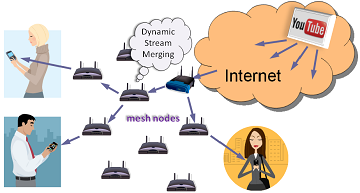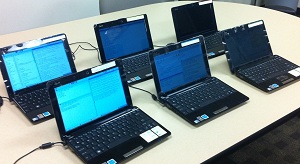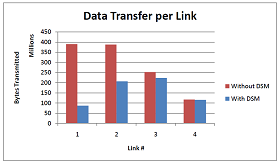

Rapid advances in wireless technology in the past decade have forever changed the way people access information on the go. The freedom provided by the latest wireless technologies like 3G/4G cellular networks or wireless mesh networks is now causing a dramatic shift in how people consume multimedia, especially streaming video. This convenience for consumers is not without challenges, however, as many wireless network carriers have discovered.
The fundamental problem is that unlike in wired networks, using a dedicated wireless stream for each video request is expensive. In multi-hop wireless networks especially, maintaining one dedicated stream per user severely limits scalability and can lead to network collapse in the face of a sudden surge in popularity of certain videos. Finding solutions for this problem is also vital for services which experience the so-called 80-20 access pattern, where about 80% of demand is for around 20% of videos.


Existing multicast solutions like Patching are unsuitable for wireless mesh access networks because the video server generaly cannot participate in the mesh network protocols. Proxy servers are similarly unsuitable because they reduce strain on the video server but not within the mesh access network itself where they appear as just another server.
In order to address these problems, we are investigating a new in-network, distributed video-sharing technique called Dynamic Stream Merging (DSM). DSM provides scalability and robustness for video streaming in a wireless mesh network environment. Intelligent mesh nodes in the network monitor the video streams to detect duplicates. By employing a merging buffer, the recent video data from an older stream can be reused in a newer copy of the stream. Merging takes place independently as needed throughout the mesh network, incrementally constructing a wireless multicast tree which is able to evolve to service new requests and adapt to the dynamics of user mobility. DSM saves precious wireless resources and improves the robustness of the network without requiring cooperation with either the video source or the users.


Scalability tests performed on prototypes and simulations revealed that DSM can keep a network running smoothly under demand that would cripple a traditional mesh network. In a simulation of 25 mesh nodes, heavy demand causes unacceptable level of packet loss as a result of wireless interference in the non-DSM system while the DSM shows drastically reduced degradation levels, well within acceptable limits.
These results closely match those obtained from our prototype system running on a testbed of 8 netbook-powered wireless mesh routers. In the typical mesh environment, the gateway quickly becomes a bottleneck because all video streams originate from the gateway. In the DSM network, though the topology remains unchanged, the demand on the gateway is significantly reduced as the mesh nodes now act as video sources wherever a stream merge has taken place.
Conventional wisdom has been that TCP is unsuitable for video streaming due to its insistence on reliability and lack of throughput guarantees, causing most video streaming research to focus on UDP. However, in our study we have observed that TCP video streams are interesting for several reasons.
First TCP ensures that critical segments of the video, like headers, arrive completely and automatically slows the data rate over a bottleneck network link to avoid overwhelming it. Second, most commercial video streaming services use TCP as do Flash and HTML5 video, which together will be an important part of how consumers access online video content in coming years. Motivated by these observations, we created a second prototype which provides DSM support for videos played through a standard web browser and tested it with videos from a popular online video provider.
In a typical mesh network, the gateway is the video source for all videos, but in the DSM system, other mesh nodes can be video sources because of stream merging. This difference suggests new opportunities in performing handoffs of mobile clients moving through the mesh network. We are currently evaluating the performance of a DSM-aware mobility management technique.



Journal Publications:
- Fei Xie, Kien A. Hua, and Ning Jiang, “Optimizing Patching-based Multicast for Video on Demand in Wireless Mesh Networks,” in a special issue on next generation networks of the International Journal of Communication Systems, Vol. 23, Issue 9-10, September-October, 2010, pp. 1057-1077. [paper]
- Fei Xie, Kien A. Hua, and Ning Jiang, and Yao H. Ho, “Study of Patching-based and Caching-based Video-on-Demand in Multi-Hop WiMax Mesh Network,” in a special issue on architectures and protocols for wireless mesh, ad hoc, and sensor networks (selected papers from IEEE Conferences on Local Computer Networks in recent years) of the Wireless Communications and Mobile Computing journal, Vol. 11, Issue 3, March 2011, pp. 357-370. (invited paper) [paper]
- Ai H. Ho, Yao Ho, and Kien A. Hua, “Handling High Mobility in Next-Generation Wireless Ad Hoc Networks,” in a special issue on next generation networks of the International Journal of Communication Systems, Vol. 23, Issue 9-10, September-October 2010, pp. 1078-1092. [paper]
- Ai H. Ho, Yao H. Ho, Kien A. Hua, and Han-Chieh Chao, “An Efficient Broadcast Technique for Vehicular Networks,” to appear in Journal of Information Processing Systems (invited paper).
Conference Papers:
-
Kien A. Hua, and Fei Xie, “A Dynamic Stream Merging Technique for Video-on-Demand Services over Wireless Mesh Access Networks,” in Proc. of IEEE International Conference on Sensor, Mesh and Ad Hoc Communications and Networks (SECON’2010), Boston, June 21-25, 2010.
[paper] -
Antoniya Petkova, Kien A. Hua, and Soontharee Koompairojn, “Processing Approximate Rank Queries in a Wireless Mobile Sensors Environment,” in Proc. of International Conference on Mobile Data Management (MDM’10), Kansas City, May 23-26, 2010.
[paper] -
Yao H. Ho, and Kien A. Hua, “Failure-Resilient Vehicular Networks,” in Proc. of IEEE Conference on Local Computer Networks (LCN’2010), October 10-13, 2010, pp. 340-343.
[paper] -
Fuyu Liu, Yao-Hua Ho, and Kien A. Hua, “Privacy Protected Query Processing with Road Network Embedding,” in Proceedings of 25th IEEE International Conference on Advanced Information Networking and Applications (AINA), March 22-25, 2011.
[paper] -
Jun Ye and Kien A. Hua, “Scalability Study of Wireless Mesh Networks with Dynamic Stream Merging Capability,” (Distinguished Paper Presentation Award) in Proceedings of 4th International Conference on Multimedia Communications, Services and Security (MCSS’2011), June 2-3, 2011, Krakow, Poland. (Distinguished Paper Presentation)
[paper] -
Steven Nichols and Kien A. Hua, “Design and Implementation of Intelligent Mesh Nodes for Wireless Video Stream Sharing,” (Best Paper Award) in Proceedings of ACM International Conference on Internet Multimedia Computing and Service, August 5-7, 2011, Chengdu, China. (Best Paper Award)
[paper] -
Fei Xie and Kien A. Hua, “Sharing Online Video Streams in Wireless Mesh Access Networks,” to appear in Proc. of IEEE Globecom 2011, Houston.
[paper] -
Ai Hua Ho, Yao Hua Ho and Kien A. Hua, “Mercury-like Routing for High Mobility Wireless Ad-hoc Networks,” to appear in Proc. of IEEE LCN 2011.
[paper]
